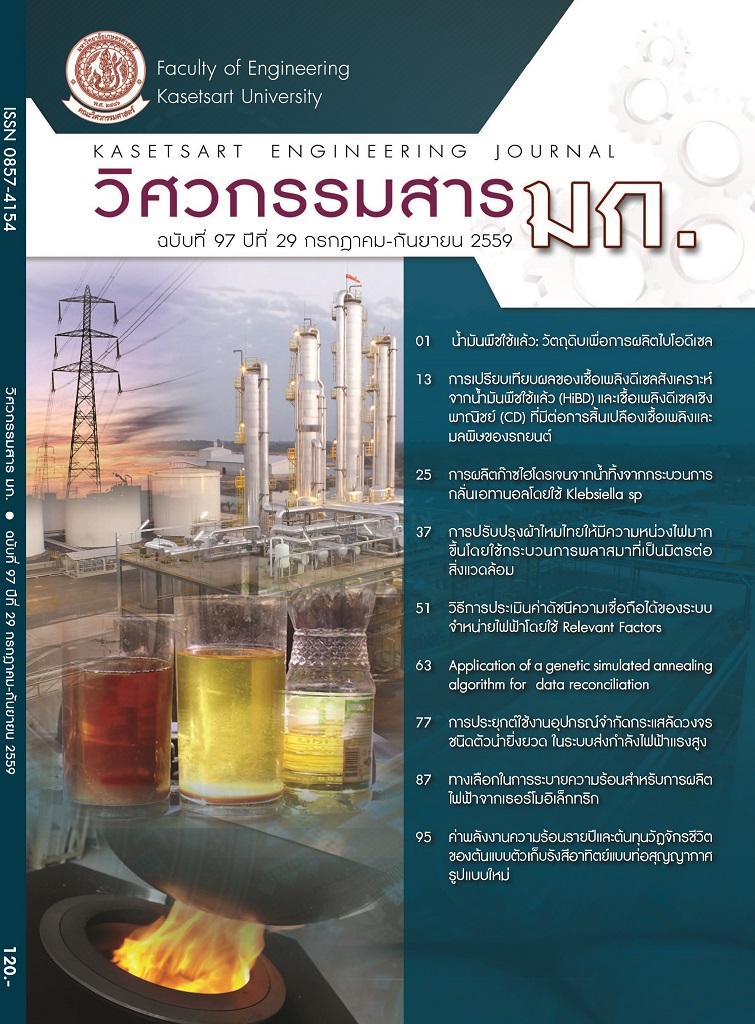การปรับปรุงผ้าไหมไทยให้มีความหน่วงไฟมากขึ้นโดยใช้กระบวนการพลาสมาที่เป็นมิตรต่อสิ่งแวดล้อม
Keywords:
13.56 MHz, พลาสมาคลื่นความถี่วิทยุ, สารหน่วงไฟ, ผ้าไหมไทย, RF plasma, flame retardant, Thai silkAbstract
งานวิจัยนี้ได้สร้างพลาสมาแชมเบอร์โดยใช้คลื่นวิทยุความถี่ 13.56 MHz ในการเหนี่ยวนำให้เกิดอาร์กอนพลาสมาเพื่อใช้แอกติเวทพื้นผิวผ้าไหมไทยเพื่อเคลือบสารหน่วงไฟ เริ่มจากแอกติเวทผ้าไหมในพลาสมาที่ระดับกำลัง 50 100 และ 150 W ความดันก๊าซ 2×10-1 และ 8×10-1 Torr ระยะเวลาในการแอกติเวท 5 และ 10 นาที แล้วนำมาจุ่มในสารหน่วงไฟ 3 ชนิดที่ศึกษา (Ciba® Pyrovatim® PBS, Diethyl 2-(acryloyloxyethyl) phosphate และ 2-carboxyl ethyl(phenyl) phosphinic acid) จากการวิเคราะห์ด้วยกล้องจุลทรรศน์อิเล็กตรอนแบบส่องกราด สามารถสังเกตเห็นสารหน่วงไฟเคลือบเกาะติดอยู่บนเส้นใยผ้าไหมอย่างต่อเนื่องหลายบริเวณจากการวิเคราะห์ด้วยเทคนิค FTIR สามารถสังเกตเห็นบางพีคซึ่งเป็นเอกลักษณ์ของสารหน่วงไฟที่เคลือบติดอยู่ เมื่อทดสอบการหน่วงไฟและความคงทนต่อการซักล้าง สารหน่วงไฟทั้ง 3 ตัวที่ได้เคลือบเกาะติดบนพื้นผิวผ้าไหม ทำหน้าที่ได้เป็นอย่างดีและคงทน ถึงแม้สารหน่วงไฟบางชนิดจะติดไฟ แต่ไฟก็ดับลงได้ภายในเวลาไม่กี่วินาทีและเกิดเขม่าดำขึ้นบริเวณที่ติดไฟ
Improvement of Flame Retardancy of Thai Silk Fabric by Environmentally-Friendly Plasma Treatment Process
A plasma chamber was constructed using a 13.56 MHz radio frequency to generate argon plasma. The plasma was used to activate silk surface in order to graft flame retardant chemicals. The process started with activating silk specimens in the plasma at the RF power of 50, 100 and 150 W, gas pressure of 2×10-1 and 8×10-1 Torr and activation time of 5 and 10 minutes. Afterwards, the specimens were quickly submerged into each of the 3 studied flame retardant solutions (Ciba® Pyrovatim® PBS, Diethyl 2-(acryloyloxyethyl) phosphate and 2-carboxyl ethyl(phenyl) phosphinic acid). From observation with scanning electron microscope, the surfaces clearly appeared to be continuously coated with flame retardant chemicals at numerous locations. From FTIR analysis, some characteristic peaks of the flame retardant chemicals could be observed. From the flame retardant and laundering durability test, all the 3 flame retardant chemicals performed well and durably because although some grafted specimens caught fire, the flame extinguished within a few seconds with char formation in the burnt area.


